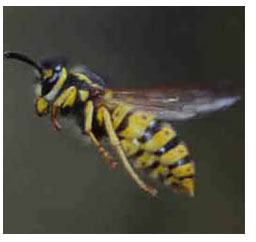Social Wasps
 Social Wasps all have the typical “wasp” body type. They have a very distinct head that possesses chewing mouthparts, short-elbowed antennae, and large compound eyes. These wasps include Yellow Jackets, Baldfaced Hornets, and Paper Wasps. Wasps and bees are beneficial insects for our environment. They are mostly feared for their sting.
Social Wasps all have the typical “wasp” body type. They have a very distinct head that possesses chewing mouthparts, short-elbowed antennae, and large compound eyes. These wasps include Yellow Jackets, Baldfaced Hornets, and Paper Wasps. Wasps and bees are beneficial insects for our environment. They are mostly feared for their sting.
While bees generally only sting once, after which they loose their sting apparatus, wasps are able to retrieve their stinging mechanism. This can result in being stung a multiple number of times by only one wasp.
Both bees and wasps can be very aggressive in spring and summer and will attack anything they consider an immediate threat.
Social Wasps have large nests that have three types of individuals or castes: queens, workers and males. The males and queens are produced in the colony in late summer. Wasps are very protective of their nests and will defend them against invaders with their painful stings. These insects can produce very large colonies with some Yellow Jacket nests having as many as 30,000 individuals.
These insects are generally considered beneficial because they feed their young on a wide variety of insects such as Spruce Budworm, Tomato Hornworm, etc. Unless they are nesting in an area frequented by people, especially small children and the elderly, it is usually recommended that they be left alone to help provide their own form of pest control.
 Social Wasps all have the typical “wasp” body type. They have a very distinct head that possesses chewing mouthparts, short-elbowed antennae, and large compound eyes. These wasps include Yellow Jackets, Baldfaced Hornets, and Paper Wasps. Wasps and bees are beneficial insects for our environment. They are mostly feared for their sting.
Social Wasps all have the typical “wasp” body type. They have a very distinct head that possesses chewing mouthparts, short-elbowed antennae, and large compound eyes. These wasps include Yellow Jackets, Baldfaced Hornets, and Paper Wasps. Wasps and bees are beneficial insects for our environment. They are mostly feared for their sting.